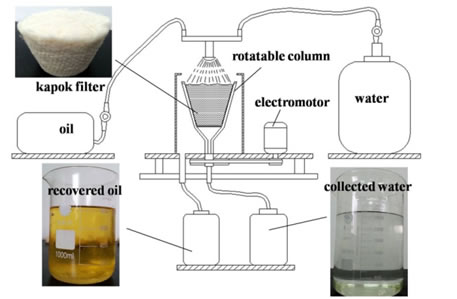Recently, the researchers at the college of textile of Donghua University presented important advance in the cleanup and recovery of oil spillages in wastewater. The researchers in Guangbiao Xu’s group reported a depth filtrating system which can highly remove and recover oils from wastewater. The structured oil filters who shows high capacity to absorb and retain the oils is designed with regulated pores by utilizing a natural hollow fibrous material called kapok fiber. This research was published in Journal of Hazardous Materials(J Hazard Mater 321(2017): 859-867, 1-7http://doi.org/10.1016/j.jhazmat.2016.10.005), entitled “Highly efficient and recyclable depth filtrating system using structured kapok filters for oil removal and recovery from wastewater”.

Oil spillages in wastewater are persistent environmental pollutants. High oil contamination in water bodies gives adverse effect on aquatic organisms, human economy, and tourism activities due to its coating properties as well as unpleasant view and odor. Oil is a class of pollutants with very low affinity to water. They can exist in water with various forms such as free oil, dispersed oil, emulsified oil and dissolved oil. The removal of them from wastewaters is often challenging and involves the combination of different treatment technologies. Filtration is a method which removes oils from the running water by utilizing hydrophobic and oleophylic materials. This method is simple and efficient without high energy requirements or production of hazardous sludge. The traditional filtration system usually use expensive synthetic polymers as the oil filters which are efficient in oily water separation, but also present poor reusability and cause post environmental pollution after discarded. In contrast, natural organic materials, especially fibrous materials, have charming properties, such as excellent oil sorption performance, richness in nature, environmental friendliness and cost-effectiveness. The research of such materials is attracting more and more attentions.Kapok fiber is a naturally hydrophobic and oleophilic plant fiber which attracts various academic attentions for its unique hollow lumen structure. As a natural sorbent for oil sorption, the excellent oil sorption capacity of kapok fibers were reported by researchers from Nanyang Technological University, Universiti Teknologi Petronas and Indian Institute of Technology, as well as Prof. Aiqin Wang in Chinese Academy of Sciences and Prof. Guangbiao Xu in Donghua University.
The researchers in Prof. Guangbiao Xu’ group investigated the adsorption and adhesiveness of oils on single kapok and characterized size and adhesive energy distribution of adsorbed oil droplets on fiber based on Carroll’s theory of droplet morphology. Based on the research, they regulate the porous structure of oil filters consisting of kapok fibers via air-laying-bonding method and fabricated the highly porous structured kapok filters which show high capacity of oil absorption and retention. In contrast to the conventional filter column which is a fix cylinder, the Guangbiao Xu’ group develop a depth filtrating system with the rotatable and taper-shaped filter column. Therefore, the oil removed from wastewater was then recovered from the oil-loaded filter by rotating the filter column, and the resulted filter was reused. The result of this research presents key advance in the design of oily filtration system and the fabrication of fibrous oil sorption materials. The technique is believed to present important application in cleanup and recovery of future oil spillages.

